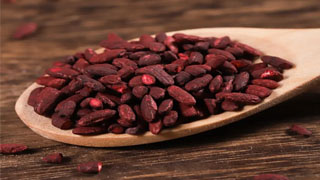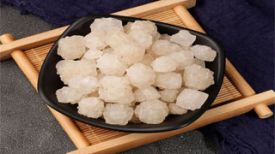
1. Aliases
Chiqu, Danqu, Hongmi, Fuqu, Hongmi, Hongcao.2. Bacterial morphology
The mycelium has a large number of branches, initially colorless, gradually turning red, and later purple red when old; The mycelium has a septum, multiple nuclei, and contains orange red particles. When mature, single or clusters of conidia are produced at the top of the branch. Conidia are brown in color, (6-9) microns x (7-10) microns. At the top of the other mycelium, a single spherical ascus (closed capsule) with orange red color is also produced; The closed capsule is orange red in color, nearly spherical in shape, with a diameter of 25-75 microns, and contains multiple asci. Ascicles are spherical and contain 8 ascospores. After maturity, the ascospore wall disappears. Ascospores are ovoid or nearly spherical, smooth, transparent, colorless or light red, (5.5-6) micrometers x (3.5-5) micrometers.
3. Origin distribution
This bacterium is commonly found in dairy products in nature, and can also be artificially cultivated using glutinous rice as a medium to produce red yeast rice. Distributed in Hebei, Zhejiang, Fujian, Jiangxi, Guangdong, Taiwan and other places.
4. Harvesting and processing
Take 100 grams of clean rice, add 110 milliliters of boiling water, and put it into a large triangular flask or other fermentation vessel. After 30 minutes of high-pressure sterilization at a pressure of 718.2 Pa, add the red yeast strain to the surface of the solid culture medium under sterile conditions. Cultivate at a constant temperature of 30 ℃, and after about 3 days, all the rice will turn purple red.
5. Characteristics of medicinal herbs
Red yeast medicinal herbs are elongated, cylindrical or irregularly shaped, and slightly flattened. The surface is purple red or brownish red, uneven, and some have light vertical and horizontal textures. Crisp texture, easy to break along the transverse grain, with a flat cross-section, red to dark red edges, slightly concave in the middle, white to light red. Qi is unique, with a light and slightly sweet taste.
6. Nature, taste, and meridian tropism
Warm in nature and sweet in taste. Guigan Meridian, Spleen Meridian, and Large Intestine Meridian.
7. Effect and function
Promoting blood circulation and removing blood stasis, strengthening the spleen and promoting digestion. It belongs to the category of disinfectant.
8. Clinical applications
Internal administration: decoction, dosage 6-15 grams; Or into pills or powder. External use: In moderation, apply by tamping. Indications: Prolonged postpartum lochia, abdominal pain caused by stasis, injuries from falls and bruises, fullness and bloating of food, red and white dysentery, and insufficient appetite. It can also be used for auxiliary treatment caused by hyperlipidemia and atherosclerosis.
9. Pharmacological research
① Hypotension and lipid-lowering effects: Red yeast has a good effect on lowering blood pressure in patients with low renin hypertension Antibacterial effect: Red yeast can produce antibacterial active substances, which have antibacterial activity against Bacillus, Streptococcus, Pseudomonas, and other genera. Its antibacterial activity is produced by two pigments, Mengna Yuhong and Panhong amine Other effects: After fermentation of red yeast, coenzyme Q10 can be isolated. Coenzyme Q10, also known as quinone, is an activator of cellular metabolism and respiration, which can improve mitochondrial respiratory function and promote oxidative phosphorylation reactions. It is also a natural oxidant produced by cells themselves, which can inhibit mitochondrial peroxidation and protect the integrity of biofilm structure. It has a non-specific enhancing effect on immunity, which can increase the phagocytic rate of phagocytes, increase antibody production, and improve T cell function.
10. Chemical composition
Enzymes: including saccharifying enzymes, maltase, pectinase, etc., as well as dextrinase, amylase, starch 1-4 glucosidase, protease, carboxypeptidase, etc. Among them, there are five types of red yeast enzyme glucose amylase. Pigments: Two red pigments, namely Pan Hong and Meng Na Yu Hong, two yellow pigments, namely Meng Na Yu and Anka Huang, and two purple pigments, namely Pan Hong amine and Meng Tian Hong amine. Monascus pigments: Monascus pigment, Monascus pigment, Monascus pigment, Monascus pigment, Monascus pigment, Monascus pigment. Red yeast polysaccharides: galactose, glucose, mannose. The fermentation products of Monascus still contain ergosterol, stearic acid, citric acid, succinic acid, lactic acid, oxalic acid, acetate nucleoside enzyme, as well as trace amounts of acetaldehyde, formic acid, fusel oil, acetone, 3-hydroxybutanone, etc.
11. Taboos for use
Pregnant women with insufficient spleen yin and no blood stasis should take it with caution.
12. Compatibility prescription
① Treatment for stagnation of diet, chest and diaphragm fullness, and indigestion: 9g of red yeast, 6g of malt, 9g of hawthorn, boiled in water twice a day. (From Liu Bo's "Chinese Medicinal Fungi")
② Treatment of abdominal pain: Red yeast, Xiangfu, frankincense and other ingredients. For the sake of the end, wine attire. ("Picking Xuan Fang")
③ Treating frequent vomiting in children, not consuming dairy products, and having hot palms and feet: red yeast (aged) costs three and a half yuan, white atractylodes macrocephala (stir fried with bran) costs one and a half yuan, and licorice (roasted) costs one and a half yuan. At the end. Take half a serving and fry jujube and rice soup. (The Compendium cites the Economic (Experimental) Formula)
The content of the article is for clinical reference only. Non professionals in traditional Chinese medicine are not allowed to try medication.


